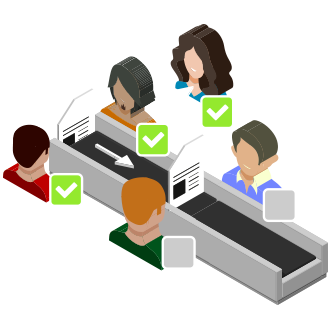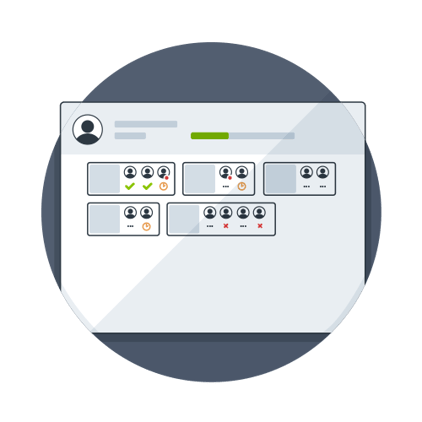Share this
How To Implement Work Management & Improve Your Company's Productivity
by Gary Fisher on June 30, 2021 3:20:17 AM EDT
Although the term “work management” has only gained popularity in recent years, you’ve likely dealt with some forms of managing work, be it at work, at home, or school.

Probably most of us are more familiar with the term “project management,” the art of managing projects with deadlines. Work management, however, is a different concept altogether, although it does share some similarities with project management.
So, what are the differences between project management and work management? How can you implement work management (and potentially, work management software) in your organization and benefit from it? This article will answer these questions and discuss all you need to know about work management.
What Is Work Management?
According to Gartner, work management is:
"A set of software products and services that apply workflow structure to the movement of information as well as to the interaction of business processes and human worker processes that generate the information. Work management software streamlines and transforms crucial business processes and thus can improve results and performance."
In layman’s terms, work management is how we use software and technologies to manage business processes so we can maximize the chance of achieving the process’s objectives.
Work management differs from project management in scope: project management only deals with projects that are limited by deadlines with clear objectives and requirements to define their successes.
Work management, on the other hand, can encompass multiple projects and business processes and is a continuous process. Work management’s success is measured by whether the organization or business can achieve continuous growth.
Thus, we can say that work management is more flexible in nature, while project management is designed to be structured and rigid.
Work management, in practice, is about managing business process workflow and team workloads. This will include managing work at an individual level like managing tasks and emails to managing overarching processes that encompass the whole organization.
How Work Management Works?
While the actual process may vary for each business process workflow, work, and even individual task, work management always involves at least three core phases:

-
Identifying Work
Before anything else, work management must first identify the work in question, be it an individual task, a business process/workflow, or a project. If necessary, the work must be broken down into its most granular form (i.e. breaking down a process into a set of tasks). We should also identify the purpose/objective of the work, the resources required, and who’s involved to execute the work.
-
Analyzing Work
Once the work has been identified, it must be analyzed thoroughly. We should examine how the work operates, identify bottlenecks and areas that can be improved, and plan what improvements can be made. We should analyze the work by attempting to answer the critical question: “how can we further optimize this work to be more efficient and productive?”.
-
Implementing Optimization
The objective of any work management is optimization. Once we’ve analyzed what changes and optimizations should be made, we can move onto implementation. We should then test whether the implemented changes cause positive results or whether another cycle of work management should be performed.
Challenges in Implementing Work Management
Implementing work management, especially in a complex organizational environment, can be a very challenging task for managers, and here are some of the key challenges to consider:
Allocating tasks to the right people
Allocation of tasks is arguably the most critical foundation of any work management. If tasks aren’t assigned to the right people with the right competency and availability, then the execution won’t be effective and efficient. Managers must assign each task to the right person at the right time, and this can be very difficult in complex organizations involving a wide variety of business processes. A centralized monitoring solution where managers can have a bird’s eye view of all tasks in the organization is required.

Differentiating urgent and important tasks
It can be challenging for managers to differentiate between tasks according to their importance/urgency matrix, leading to mistakes in prioritizing different tasks. It can be difficult for managers to objectively define the right finish date for each task, leading to disputes among team members and stakeholders and hiccups in actually getting the work done.
Work Management Software
Since the scope of work management can be vast and complex, enterprise work management software like Aproove is essential to help management schedule and manage various business processes and projects and for team members to work together.
Without centralized management software, teams often must rely on too many different tools and software that are disconnected from each other. This can lead to various issues when implementing work management like the difficulty in locating information about projects, lack of transparency and accountability about who is working on what, and so on.
When people switch between tasks and different software, it can significantly reduce their productivity. A research report has suggested that mental blocks caused by switching tasks can reduce productivity by a whopping 40%.
A centralized work management solution can allow your workers to use only a single platform so they can focus more on each task with minimal distractions. Also, since information about works is also centralized and accessible to everyone, every team member and stakeholder can understand each other's roles and responsibilities, improving accountability and productivity.
A good work management software solution should allow different departments and different functions across organizations to collaborate more efficiently to further improve the organization's productivity by avoiding the "mental switching" caused by using multiple tools and solutions in each task.
Share this
- Project Management (40)
- Online Proofing (28)
- Featured (27)
- Educational (25)
- New Release (25)
- Work Management (25)
- Business Workflow (23)
- Marketing management (22)
- Workflow Management (22)
- BPM Software (20)
- Marketing Workflow (20)
- Business Automation (19)
- Newsletter (19)
- Workflow Automation (17)
- Marketing Automation (14)
- enterprise project management (10)
- business process workflow (8)
- BPM (7)
- Task Management (7)
- Aproove news (6)
- Digital Asset Management (6)
- News (6)
- insurance work management (5)
- team (5)
- Industry News (4)
- business process automation (4)
- insurance marketing (4)
- marketing process (4)
- Compliance (3)
- Retail Marketing (3)
- brands (3)
- enterprise workflow management (3)
- printing workflow (3)
- AI (2)
- Document Management Automation (2)
- IT Project Management (2)
- Marketing Agency (2)
- Product Development (2)
- creative workflow (2)
- print (2)
- workflow optimization (2)
- Case Studies (1)
- Case Study (1)
- DAM Software (1)
- Document Workflow Automation (1)
- HIPPA (1)
- Healthcare (1)
- ISO (1)
- Insider (1)
- Resource Management (1)
- SOC2 (1)
- SaaS (1)
- banking (1)
- marketing teams (1)
- security (1)
- workflow diagram (1)
- workflow process mapping (1)
- workflow software (1)
- April 2025 (6)
- March 2025 (11)
- February 2025 (10)
- January 2025 (10)
- December 2024 (9)
- November 2024 (10)
- October 2024 (5)
- September 2024 (8)
- August 2024 (10)
- July 2024 (9)
- June 2024 (11)
- May 2024 (6)
- April 2024 (7)
- March 2024 (7)
- February 2024 (6)
- January 2024 (4)
- December 2023 (3)
- November 2023 (7)
- October 2023 (7)
- September 2023 (3)
- August 2023 (5)
- July 2023 (3)
- June 2023 (1)
- May 2023 (1)
- April 2023 (1)
- February 2023 (2)
- September 2022 (3)
- August 2022 (1)
- July 2022 (1)
- May 2022 (1)
- March 2022 (3)
- February 2022 (3)
- January 2022 (3)
- November 2021 (2)
- October 2021 (2)
- September 2021 (1)
- August 2021 (4)
- July 2021 (4)
- June 2021 (2)
- May 2021 (3)
- April 2021 (1)
- February 2021 (1)
- November 2020 (1)
- October 2020 (2)
- July 2020 (4)
- June 2020 (2)
- May 2020 (2)
No Comments Yet
Let us know what you think